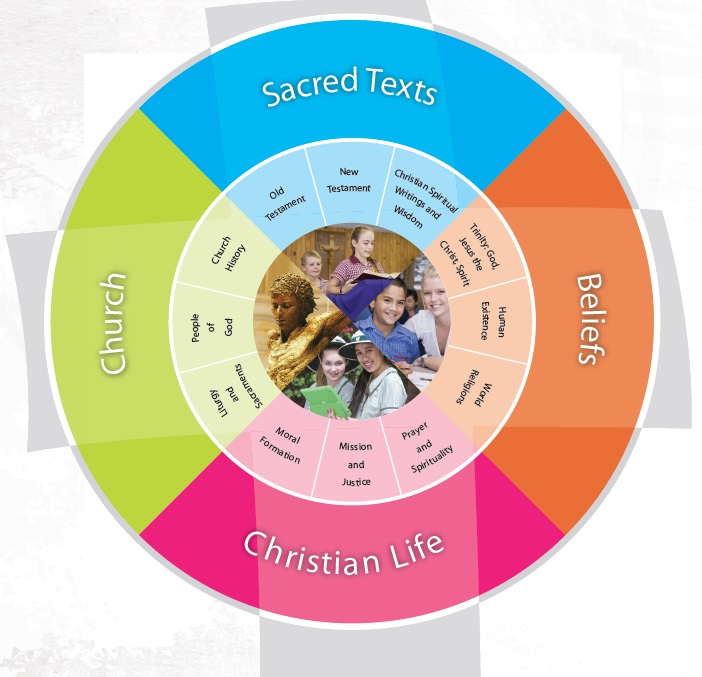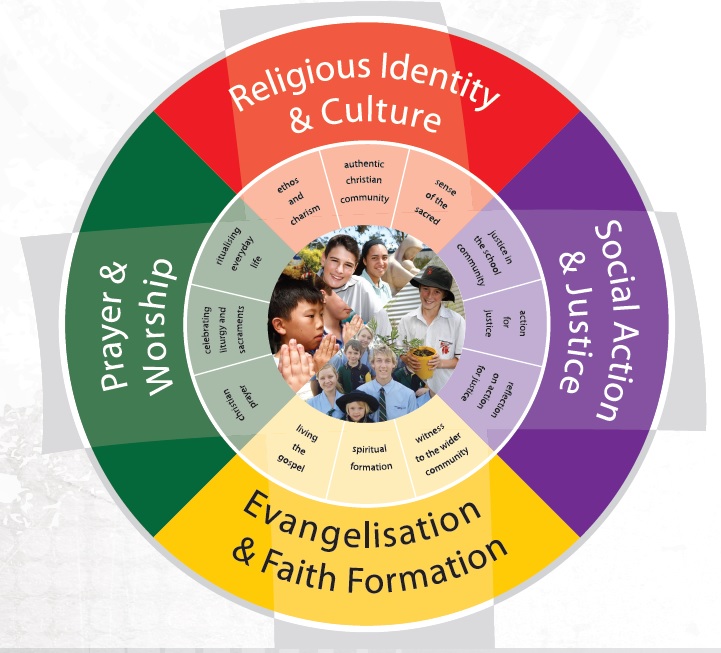The Vision for Religious Education as stated in the Religious Education Curriculum of Brisbane Catholic Education gives voice to what our hopes for our students here at Immaculate Heart in terms of their religious literacy and faith formation.
“The schools and colleges of the Archdiocese of Brisbane aspire to educate and form students who are challenged to live the gospel of Jesus Christ and who are literate in the Catholic and broader Christian tradition so that they might participate critically and authentically in faith contexts and wider society”
Religious Education consists of two distinct but complementary dimensions, namely an educational dimension and a faith formation dimension. The first dimension, most commonly referred to as the classroom teaching and learning of religion, is focused on Religious Education as an educational activity.  It utilises a range of teaching and learning processes and resources. The second dimension, faith formation, is reflected in the religious life of the school, family and parish. The educational dimension and the faith formation dimension are inextricably linked. The classroom teaching of religion is one element in a complex web of experiences that have the potential to nurture the faith life of young people.
It utilises a range of teaching and learning processes and resources. The second dimension, faith formation, is reflected in the religious life of the school, family and parish. The educational dimension and the faith formation dimension are inextricably linked. The classroom teaching of religion is one element in a complex web of experiences that have the potential to nurture the faith life of young people.
All classroom teachers are working from the Brisbane Catholic Education Religious Education Syllabus and  Curriculum documents. Religious Education aims to "develop students' religious literacy in the light of the Catholic tradition, so that they may participate critically and effectively in the light of their faith communities and wider society" (A Syllabus for Religious Education for Catholic Schools). The curriculum involves four strands:
Curriculum documents. Religious Education aims to "develop students' religious literacy in the light of the Catholic tradition, so that they may participate critically and effectively in the light of their faith communities and wider society" (A Syllabus for Religious Education for Catholic Schools). The curriculum involves four strands:
Sacred Texts
Beliefs
Church
Christian Life
Theses strands are interrelated and are taught in an integrated approach which are appropriate to the learning contexts of the class.
At Immaculate Heart it is a requirement that a minimum of 2.5 hours per week of religion teaching is provided. This time is allocated in the way that best meets the needs of our students.
 The Religious Life of the School also comprises four interrelated components:
The Religious Life of the School also comprises four interrelated components:
Religious Identity & Culture
Evangelisation & Faith Formation
Prayer and Worship
Social Action & Justice
Each of these components, while mutually reinforcing, provides a significant focus on a distinctive aspect of the religious life of our school and compliments the teaching of religion within classroom.
The classroom teaching of religion involves the following content here at Immaculate Heart:
Prep
God of Love: Students learn about some Old Testament and New Testament stories and identify some connections between the stories and their personal experience.
Jesus: Students listen and respond to stories of and about Jesus in the Gospels.
Right and Wrong: Students learn that Christian believe God created people with freedom to choose between right and wrong and explore Jesus' teachings about love, compassion and forgiveness.
Prayer: Students learn about ways in which believers pray.
Celebration and Rituals: Students explore ways in which believers pray together during special celebrations and rituals.
Year 1
Creation: Students explore the Christian teaching that all people are created in God's own image, with dignity and natural rights.
Baptism: Students explore the words, actions and symbols used in the Sacrament of Baptism.
Jesus' Ministry: Students investigate Jewish daily life and explore accounts of Jesus from the Gospels to learn about the nature of Jesus' mission and ministry.
Mary: Students explore the ways in which Mary, Mother of Jesus, is honoured by Christians past and present.
Ways of Praying: Students investigate how prayer was a part of Jesus' life and the lives of believers.
Year 2
Jesus' Mission and Ministry: Students explore the purpose and nature of Jesus' mission and ministry as depicted in some Gospel stories.
Covenant: Students discuss their ideas about God's relationship with the Jewish people as described in some Old Testament stories.
The First Century Mediterranean World: Students explore the life and times of Jesus.
Loving God: Students develop their understanding of the loving relationship God offers to people unconditionally and investigate ways in which believers celebrate reconciliation with God and with others.
The History of Immaculate Heart: Students explore the history of our parish community.
Sacredness of all Creation: Students explore what it means to be called to be co-creators and stewards of God's creation.
Prayer and the Wisdom of the Saints: Students examine ways in which prayer and the wisdom of the saints help to nurture a loving relationship with God, others and all creation.
Year 3
Relationship with God: Students develop their understanding of God's relationship with people as individuals and as communities.
Presence and Action of God: Students develop an appreciation of the Scripture as a basis for Christian moral living.
Creation: Students explore the order and harmony of creation.
The Gospels: Students explore the cultural context in which the gospels were written to develop their understanding of the life and teachings of Jesus.
Our Church: Students explore the significant features of a parish and diocese.
Praise and Thanksgiving: Students explore prayers of thanksgiving and praise.
Year 4
God as Father, Son and Holy Spirit: Students explore the Christian belief that God, as Trinity, is relational in nature by investigating Scriptural passages.
Significance of Community: Students explore the significance of living in a loving relationship with God, others and all of creation.
Jewish Communities: Students will explore why the worship of Jewish communities has changed since the time of Jesus and identify aspects that remain the same.
Free Choices: Students will explore how free choice results in actions that affect the individual and their community.
Sacraments of Healing: Students will explore the practices and characteristics of the Sacraments of Anointing the Sick and Penance.
Blessing, Adoration, Petition and Intercession: Students examine and create these forms of prayers.
Year 5
Community: Students explore the significance of community for sharing and strengthening the faith of believers.
Gospel Writers and Their Communities: Students use features of the Gospel texts to show how the Gospel writers shaped their Gospels for particular communities.
The Holy Spirit: Students explore the action of the Holy Spirit including Pentecost and the Sacrament of Confirmation.
Personal and Communal Prayer: Students explore the significance of personal and communal prayer and worship for communities of believers.
Mary, Mother of Jesus and Mother of the Church: Students explore Mary's role as mother of Jesus and mother of the Church are analyse the elements and features of Marian prayers.
Year 6
Leadership: Students explore their role as school leaders through the lens of Christian leadership.
Communion of Saints: Students develop their understanding of faith and explore many ways in which faith is lived out in the lives of believers.
Celebrations of Faith: Students explore the role of celebrations in the faith life of believers.
The New Law: Students investigate the New Law as given by Jesus is a law of love, grace and freedom and explore spiritual and corporal works of mercy.
Prayer through the Christian Tradition: Students explore the significance of personal and communal prayer including the Our Father, the Examen and the use of spiritual exercises.
all images © Brisbane Catholic Education (2023)